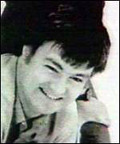Alberta man who shot father of 4 “execution style” freed
 Eifion Wyn (Wayne) Roberts (inset), an Alberta farmer who shot to death an oil patch worker, a father of four, has been granted full parole, after 15 years behind bars. The decision to release Roberts was made yesterday by the Parole Board of Canada. Roberts shot Patrick Kent on October 3, 1998, on Roberts’ farm near Bowden, 100 kilometres north of Calgary in a killing described in court as “execution style.” Witnesses to the shooting said that Roberts was holding a handgun and shouting at Kent during a confrontation. He fired several shots and Kent fell to the ground. According to the witnesses, Roberts stepped closer to the fallen man and fired several more shots into his body. An autopsy showed that one bullet traveled through Kent’s right wrist, then entered and exited through his abdomen; one entered his left temple; and three entered the back of his head. The three in the back of the head were lethal injuries. With prompt medical attention, Kent might have survived the first two.
Eifion Wyn (Wayne) Roberts (inset), an Alberta farmer who shot to death an oil patch worker, a father of four, has been granted full parole, after 15 years behind bars. The decision to release Roberts was made yesterday by the Parole Board of Canada. Roberts shot Patrick Kent on October 3, 1998, on Roberts’ farm near Bowden, 100 kilometres north of Calgary in a killing described in court as “execution style.” Witnesses to the shooting said that Roberts was holding a handgun and shouting at Kent during a confrontation. He fired several shots and Kent fell to the ground. According to the witnesses, Roberts stepped closer to the fallen man and fired several more shots into his body. An autopsy showed that one bullet traveled through Kent’s right wrist, then entered and exited through his abdomen; one entered his left temple; and three entered the back of his head. The three in the back of the head were lethal injuries. With prompt medical attention, Kent might have survived the first two.
 Roberts was convicted of second-degree murder and sentenced to life in prison with no chance of parole for 15 years. The Court of Appeal of Alberta dismissed his appeal of his conviction and his appeal against the 15-year parole ineligibility period. The Supreme Court of Canada rejected his appeal of his conviction. Roberts was granted full parole and will be permitted to return to live on his farm with his wife, according to Heidi Illingworth at the Canadian Resource Centre for Victims of Crime. Though Roberts is banned for life from owning or possessing firearms, his wife can keep a firearm in a locked cabinet at the home.
Roberts was convicted of second-degree murder and sentenced to life in prison with no chance of parole for 15 years. The Court of Appeal of Alberta dismissed his appeal of his conviction and his appeal against the 15-year parole ineligibility period. The Supreme Court of Canada rejected his appeal of his conviction. Roberts was granted full parole and will be permitted to return to live on his farm with his wife, according to Heidi Illingworth at the Canadian Resource Centre for Victims of Crime. Though Roberts is banned for life from owning or possessing firearms, his wife can keep a firearm in a locked cabinet at the home.
At trial, Roberts argued self defence, but the trial judge refused to permit them to consider the notion that Roberts was provoked. The jurors were not permitted to hear about two previous instances in which Roberts pointed a firearm at someone and made threatening comments. The trial judge described Roberts as “a highly volatile and easily angered man who was quick to resort to the use of firearms to deal with those who crossed him or did not do what he wanted. He is a dangerous man.”
Kent (inset right) was the vice president of KB Resources, a small oil patch firm that operated an old well on property that it leased from Roberts. The well had leaked and soil around it was contaminated. Roberts has expressed concern about KB’s ability and willingness to clean up the problem. On the day Kent was killed, he and Roberts argued about the cleanup.
This story from 2000 details the conviction of Roberts and was published before sentence was passed:
By Andrew Nikiforuk – For Business Edge
Published: 11/15/2000 – Vol. 1, No. 6
Before the jury quickly delivered its verdict of murder in the second degree; before Judge Peter Martin sonorously delivered his charge; and before the Crown and defence summarized their final arguments, the man accused of murdering oil executive Patrick Kent took the stand last week and told his version of a grim day that shocked the oilpatch.
Eifion Wyn Roberts, a diminutive rancher and welder with a whispery Welsh accent, had a lot to say and often said it in an angry and abrupt manner under heavy cross examination.
The landowner began by admitting he had shot Kent in self defence on the afternoon of Oct. 3, 1998, after threatening to arrest the oil man for trespassing on his land.
Roberts confessed that he never expected the six foot 42-year-old father of four to charge him and react the way he did (“the rage on that man’s face — he lost it completely.”)
“I didn’t want a confrontation that day . . . Surely you don’t attack a man with a gun in his hand. I just intended to wound him and stop him.”
He remembers firing one shot at Kent’s thigh and another somewhere else. Of the three remaining shots that completely shattered Kent’s brain, he has no recollection at all.
“I couldn’t believe that something like that could happen that quick. . . . his reaction and my reaction were totally wrong. . .”
Until the shooting outside of Roberts’ house that day, both men had tangled with each other in a two-year dispute over soil contamination from a suspended oil well.
While Roberts monitored and tried to gauge the extent and scale of pollution on the site on Oct. 3, (and it was sizable), Kent ordered surveyors to determine how Roberts’ barn, house and corral encroached on his company’s lease.
Each man appeared to act as though they had checkmated the other that day without any thought of the deadly consequences of their play.
Under a sharp cross examination, Roberts’ showed the jury that he could “lose it” too.
After replying to a string of questions by Crown prosecutor Larry Stein that suggested the accused had killed Kent to get rid of the well so he could make more money off his land selling gravel, Roberts verbally exploded and insinuated he was the victim of a political conspiracy.
“I think you’ve got me a little bit wrong here, Mr. Stein. What happened at my place, it was a confrontation, pure and simple, between two men . . . Had it been a next door neighbor, you would have charged me with manslaughter, and I still would have had the same defence.
“Because he was the vice-president of an oil company in Alberta, where the oil dollars feeds the provincial coffers, it was, ‘Charge this sucker with murder one. See that he doesn’t get bail, see if you can break him financially. Try to alienate him from his family’. . . Well you haven’t broke me financially, and I am here to make my defence.”
Roberts later exploded at Stein again over his description of the alleged execution-style killing of Kent — three shots to the head. “What I can say categorically, I never shot the man in the back of the head as you insinuated. The (position of the) shell casings prove it.”
Blaise MacDonald began the defence’s final argument by telling the jury “they would never meet more of a straight shooter than Wayne Roberts.”
MacDonald apologetically and quickly amended his description to “frank and blunt.”
After regaining his metaphors MacDonald reviewed ballistic evidence given by two gun experts (and Vietnam war veterans) that suggested that Kent received all five shots while standing or falling to the ground.
MacDonald then chronicled the dispute about the contamination by highlighting “the dark side of Mr, Kent”: a fax calling the landowner a “s___head,” belated rent checks, chronic inaction and an alleged threat to teach the landowner “a lesson.”
It was “Kent who snapped that day,” concluded the Nova Scotia lawyer. “And he came at Roberts, all 250 lbs of him . . . This was a tragic event. Wayne Roberts did not intend to kill Patrick Kent.”
In his final arguments, Stein argued that the murder was a “simple plan hatched by the accused while brooding over his failure to get rid of the oil well.”
He reminded the jury that Roberts shot a defenceless man in broad daylight in front of at least half dozen witnesses and killed the man with shots to the head. “That defies the laws of luck and reasonable force.”
On Oct. 3, it was Roberts, not Kent, who lost it, he said. “Can you imagine how angry he was at Patrick Kent after three years of failing to achieve his goal of getting rid of the well . . . . he picked the time and he picked the place to rid himself of Patrick Kent. You know the truth. The accused is guilty as charged.”
In the end, the Judge reminded the jury of some basic murder jurisprudence.
A verdict of murder one (and Roberts was charged with the first degree) requires clear intent that is planned and deliberate. Second degree may be intentional but not planned or deliberate. Last comes manslaughter.
After 15 hours the jury, an even number of men and women, found the 56-year-old guilty of second-degree murder and recommended no parole for 20 years.
At the announcement the widow of Patrick Kent, Linda, burst into tears while Roberts’ spouse, Jean, cried in sorrow. Sentencing arguments will be heard on Dec. 14.
Cancrime
- Rob Tripp's profile
- 8 followers




